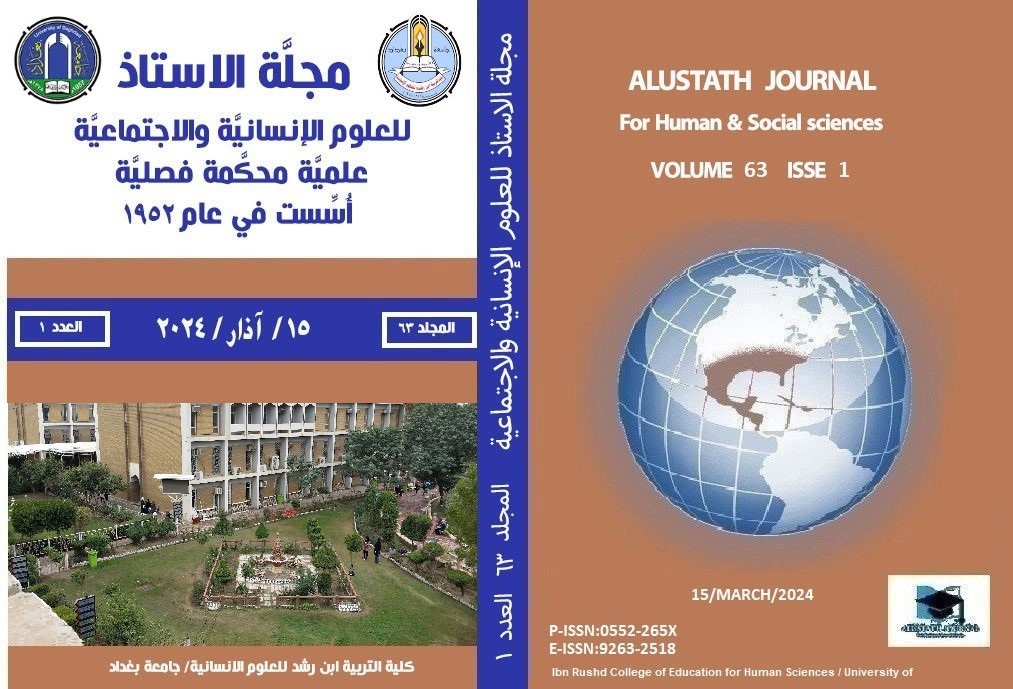Building and applying a self-purpose personality scale for university students
DOI:
https://doi.org/10.36473/ns4jwy19Keywords:
Build and apply, Scale, . self-purpose personalityAbstract
The goal of the research is to build and apply a self-purpose personality scale to a sample of students at the University of Baghdad, the size of which was (500) male and female students, including (205) male and (295) female students. For the purpose of achieving the research objectives, the researcher developed a theoretical definition of a self-purpose personality, and (42) verbal positions were formulated. In front of each situation, there are three verbal alternatives (A, B, C). The scale was corrected (1, 2, 3) respectively for alternatives to no answer for each situation. For the purpose of logical verification, the items of the scale were presented to the arbitrators and specialists in the educational and psychological sciences, and the percentage of agreement was verified as 80. % after making some adjustments to some of the positions and they were taken into account. The psychometric properties of the scale’s positions were also calculated, represented by revealing the statistical indicators of the scale and identifying the normality of the distribution of the scores. The researcher conducted exploratory factor analysis to reveal the factor structure as well as extracting the correlation of the item with the total score of the scale and calculating The discriminating power of the scale's items, as there was no non-distinctive item, and the scale's validity and reliability were verified. The same sample was taken in deriving the criteria for the scale's percentile ranks, and conclusions, recommendations, and proposals were reached.
Downloads
References
Al-Basiouni, Abdul Rahman, (1985): Measurement and Experimentation in Psychology and Education, Alexandria, Dar Al-Ma’rifa University, Cairo, Egypt.
Al-Jarakh, Karar Hussein Abd Jawad, (2021): Self-goal personality and its relationship to the cognitive style (risk-taking - caution) among graduate students, unpublished master’s thesis, Al-Qadisiyah University, College of Arts.
Harb, Sameh Hassan Saad El-Din, (2022): Psychological variables associated with the self-purposed personality among university students, Educational Journal, vol. 2, (93), pp. 755-857.
Khalaf, Azhar Youssef, (2021): The Patient Personality among Samarra University Students, Center for Psychological Research, Volume (32), Issue (3), pp. 697-726.
Al-Sharqawi, Anwar Muhammad, Sheikh Suleiman Al-Khudari, Kazem, Omnia Muhammad, and Abdel Salam, Nadia Muhammad, (1996): Contemporary Trends in Psychological and Educational Measurement and Evaluation, Cairo, Anglo-Egyptian Library.
- Al-Sammadi, Abdullah, and Al-Darabie, Maher, (2004): Psychological and educational measurement and evaluation between theory and practice, 1st edition, Amman, Dar Wael for Publishing and Distribution.
Abbas, Muhammad Khalil, Muhammad Bakr Nofal, Muhammad Al-Qaisi, Faryal Muhammad, (2011): Research Methods in Education and Psychology, 3rd edition, Dar Al-Masirah for Publishing and Distribution, Amman - Jordan.
Abdul Rahman, Anwar Hussein, and Zanganah, Adnan Haqqi Shihab, (2008): Conceptual and theoretical foundations in the curricula of the humanities and applied sciences, 1st edition, Baghdad.
- Odeh, Ahmed Makkawi, Fathi Hassan, (1987): Fundamentals of Scientific Research in Education and Human Sciences, Al-Manar Library, Amman.
المصادر الأجنبية
Csikszentmihalyi, M. (1990): Flow. New York: Harper & Row.
Csikszentmihalyi, M. (1997) Finding Flow. The Psychology of engagement with everyday life. New York: Basic Books
Csikszentmihalyi, M. Rathunde, K., & Whalen, S., (1993). Talented teenagers: A longitudinal study of their development. New York: Cambridge University Press.
Deck & Ryan R. M. (1985) Intrinsicmbirvation and self-determination in E humanbehavior. Springer Science & Business Media.
Dwight CK. Tee, Vienne Wing Yen lau (2018): The Developrnent of the Autotelic ersonality Questionnaire, Article in Journal of Personality Assessment
Lüdtke (2018). Music-induced Flow Alters the Emotional Response to Environmental Scenes [Unpublished Master's Thesis]. Vienna University.
Nakamura J & Csikszentmihalyi, M., (2002): The concept of flow. Handbook of positive psychology, 89-105
Csikszentmihalyi, M. (1990). Flow: The psycholog of optimal experience. Harper Collins
Asawa, K., (2010) Flow experience, culture, and well-being: How do autotelic Japanese college students feel, behave, and think in their daily Srees? Journal of Happiness Studies, 11, 205-223.
Baumann, N. (2012). Autotelic Personality. In S. Engeser (Ed.), Advances in flow research (pp. 165-186). Springer. https://doi.org/10.1007/978-1- 4614-2359-1
Asakawa, K. (2010). Flow experience, culture, and well-being: How do autotelic Japanese college students feel, behave, and think in their daily lives. Journal of Happiness Studies, 11, 205-223. https://doi.org/10.1007/s10902-008-9132-3
Tse, D. C. K., Lau, V. W., Perlman, R., & McLaughlin, M. (2020). The development and validation of the autotelic personality questionnaire. Journal of Personality Assessment, 102(1), 88- 101. https://doi.org/10.1080/00223891.2018.1491855
Sidorová, D. (2015). Well-being, flow experience and personal characteristics of individuals who do extreme sports us serious leisure [Unpublished Doctoral Dissertation) Masaryk University.
Nakamura, J., & Csikszentmihalyi, M. (2014). The concept of flow. In M Csikszentmihalyi (Ed.), Flow and the Foundations of Positive Psychology: The Collected Works of Mihaly Csikszentmihalyi (pp. 239-263). Springer. https://doi.org/10.1007/978-94-017-9088-8_16
Gao May (2019): How Personality and Self-Perception Relate to Flow Propensity.
Asakawa, K. (2010). Flow experience, culture, and well-being: How do autotelic Japanese college students feel, behave, and think in their daily lives. Journal of Happiness Studies, 11, 205-223. https://doi.org/10.1007/s10902-008-9132-3
Yarar, O.F. (2015). Autotelic personality: Links with flow propensity, personal strengths, and psychopathology [Unpublished Doctoral Dissertation). The Middle East Technical University.
Downloads
Published
Issue
Section
License
Copyright (c) 2024 Hind S. Rahim

This work is licensed under a Creative Commons Attribution 4.0 International License.











